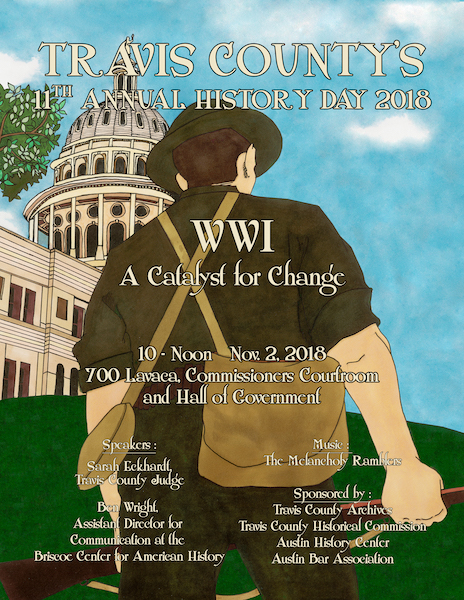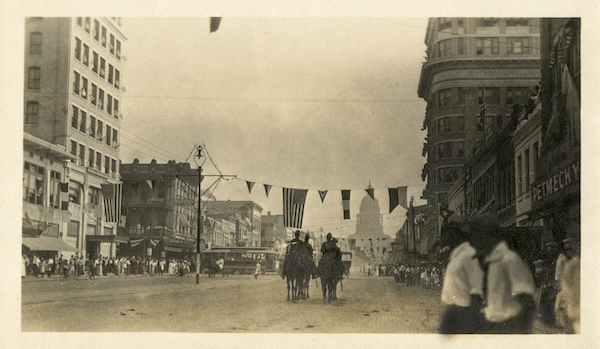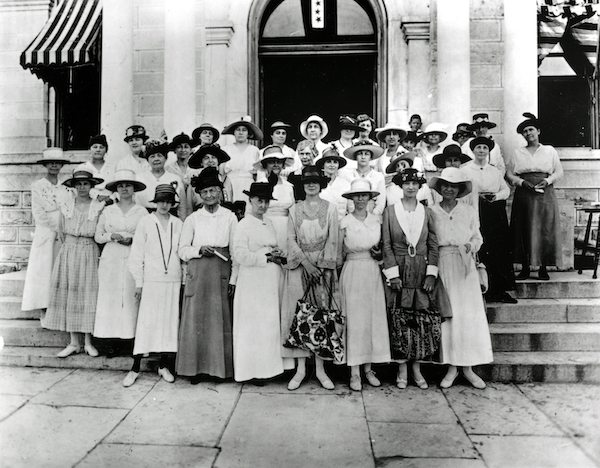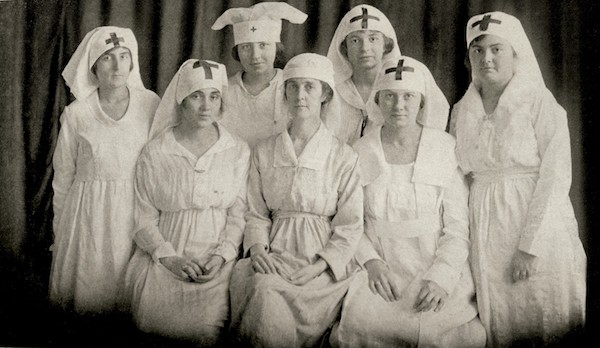History Day 2018
WWI: A Catalyst for Change

The 11th annual Travis County History Day, held in 2018, explored the impact and effect of World War 1 on Travis County. County Judge Sarah Eckhardt served as emcee, and Ben Wright, curator, researcher and writer at UT Austin’s Briscoe Center for American History, was the special speaker.
The Great War

Library of Congress
The Great War, also known as World War I, was fought between 1914 and 1918.
On July 28, 1914, Austria-Hungary declared war on Serbia, one month after a Serbian nationalist assassinated the Archduke of Austria in Sarajevo. This seemingly small conflict between two countries spread rapidly: soon, Germany, Russia, Great Britain, and France were all drawn into the war. The main members of the Allied Powers were France, Russia, and Britain, and the United States. The main members of the Central Powers were Germany, Austria-Hungary, the Ottoman Empire, and Bulgaria.
At the outbreak of fighting in 1914, the United States remained on the sidelines, adopting the policy of neutrality while continuing to engage in commerce and shipping with European countries on both sides of the conflict.
Neutrality, however, was increasingly difficult to maintain in the face of Germany’s unchecked submarine aggression against neutral ships, including those carrying passengers. In 1915, Germany declared the waters surrounding the British Isles to be a war zone, and German U-boats sunk several commercial and passenger vessels, including some U.S. ships. In April of 1917, the United States declared war on Germany.
The majority of the fighting took place in Europe along two fronts: the western front and the eastern front. The western front was a long line of trenches that ran from the coast of Belgium to Switzerland. Much of the fighting along this front took place in France and Belgium. The eastern front was between Germany, Austria-Hungary, and Bulgaria on one side and Russia and Romania on the other. Soldiers fought from dug-in positions, striking at each other with machine guns, heavy artillery, and chemical weapons. Though soldiers died by the millions in brutal conditions, neither side had any substantive success or gained any advantage. After a series of major battles, on October 3, 1918, Germany requested a cease-fire. The war ended on November 11, 1918, when the warring parties signed the Armistice and agreed to stop fighting.
World War I took the lives of more than 9 million soldiers; 21 million more were wounded. Civilian casualties caused indirectly by the war numbered close to 10 million. The two nations most affected were Germany and France, each of which sent some 80 percent of their male populations between the ages of 15 and 49 into battle.
Although the United States did not enter the war until 1917, it proved to be brutal and bloody for Americans. A total of 198,000 Texans saw service in the armed forces over the course of the war, at least 5,170 of whom gave their lives.

Photo No. PICA 07169, Austin History Center, Austin Public Library
The lasting impacts of World War 1 would change Travis County, in many ways bringing it into the modern era. Women joined the work force in unprecedented numbers, to fill jobs vacated by men who had gone to fight in the war, and to fill new jobs created as part of the war effort.
These changes helped create a momentum which eventually led to the legalization of female suffrage under the 19th Amendment. The campaign for women’s suffrage began in earnest before the Civil War, but it was decades before significant changes were to come about. The suffrage movement became more organized over the subsequent decades.
Texas women gained a meaningful victory in 1918. On March 26, 1918, following years of work and persistence by women suffragists, a bill was passed by the Texas Legislature and signed by Texas Governor Hobby to permit women to vote in primaries. The law did not go into effect for 90 days, giving women only 17 days in which to register to vote before the July primary; in those 17 days, 386,000 women registered to vote in the primary.
When the legislature convened in January 1919, Governor Hobby recommended that the Texas Constitution be amended to extend full suffrage to women, and in June of that year, Texas became the ninth state in the United States, and the first state in the South, to ratify the Nineteenth Amendment. Texas women were finally, officially, given the right to vote.

Photo No. PICA 11669, Austin History Center, Austin Public Library
Another lasting impact of World War 1 was the spread one of the world’s deadliest global pandemics, the Spanish flu epidemic of 1918, which killed an estimated 20 to 50 million people.
In Austin, the disease spread quickly. Early reports assured the public that though the disease was highly contagious, there was no just cause for alarm. However, this quickly proved to be false. On September 27, 1918, there was one reported case of influenza at Camp Mabry. On October 4, 900 cases of influenza were reported there.
As the number of cases grew, more medical facilities became involved. Hospitals became so overloaded with flu patients that schools, private homes and other buildings were converted into makeshift hospitals, some of which were staffed by medical students.

Briscoe Center for American History
Quarantine was placed on Camp Mabry. On October 8, 1918, the Austin City Council adopted an ordinance that closed “the state university, all public and private schools and colleges of the City of Austin, all churches and lodges and all other places of assemblage where people gather for religious, social, fraternal, political, business, or other purposes for the period of thirty days from the date of the enactment of this ordinance.”
By the end of October, area health officials were reporting that the influenza epidemic was under control in portions of Texas and that the situation was gradually improving. On November 2, the Austin City Council repealed the ordinance banning all public gatherings, and schools were reopened soon after. Camp Mabry prepared to lift its quarantine, and temporary hospitals that had been opened throughout the city began to be closed.
While no official record was kept, newspaper estimates put the Austin and Travis County mortality rate at approximately 277, with thousands infected.
Worldwide, the flu pandemic came to an end by the summer of 1919, as those that were infected either died or developed immunity. The exact numbers are impossible to know due to a lack of medical record-keeping in many places. However, some estimate that The Spanish flu infected an estimated 500 million people worldwide—about one-third of the planet’s population.